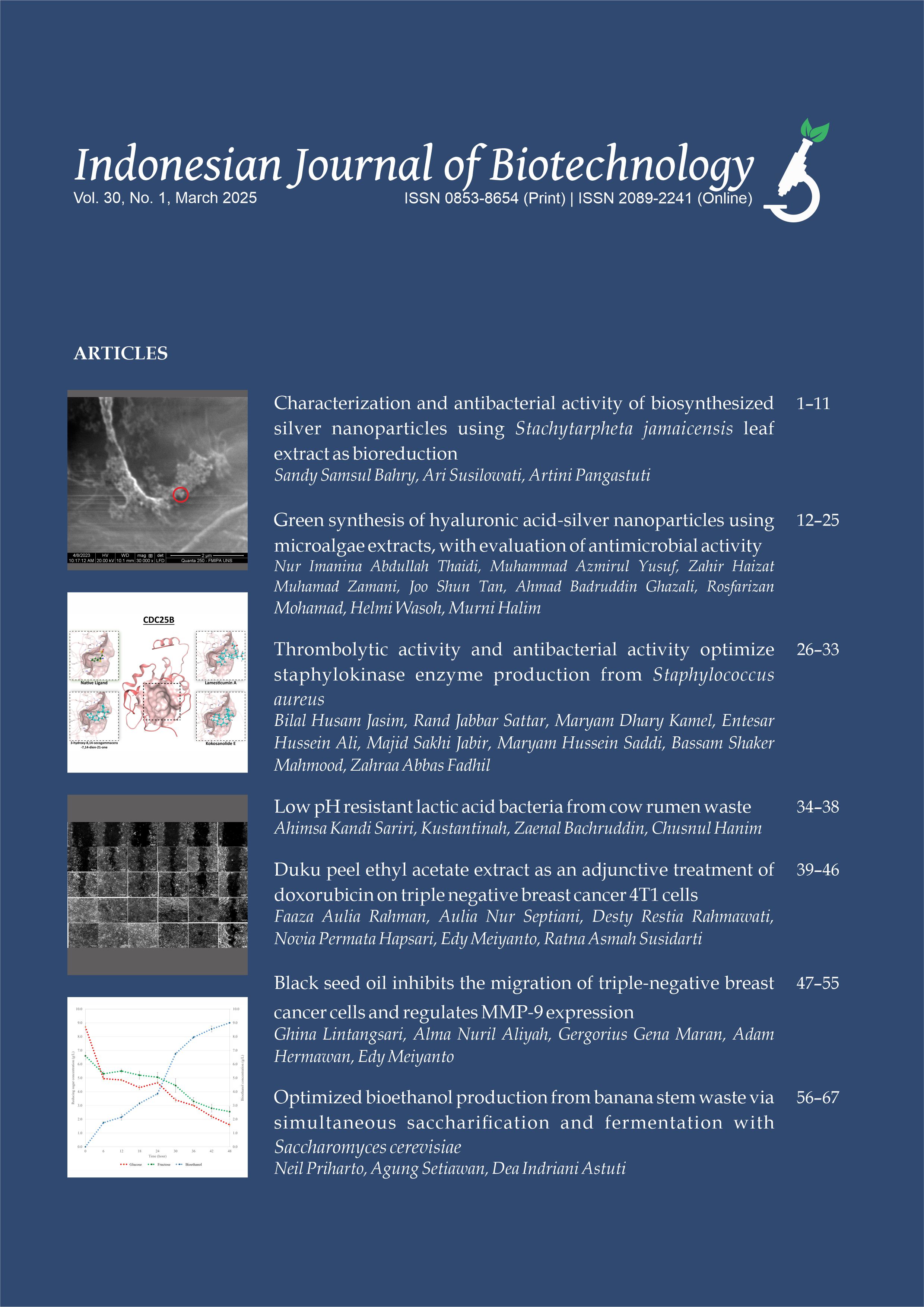Thrombolytic activity and antibacterial activity optimize staphylokinase enzyme production from Staphylococcus aureus
Bilal Husam Jasim(1*), Rand Jabbar Sattar(2), Maryam Dhary Kamel(3), Entesar Hussein Ali(4), Majid Sakhi Jabir(5), Maryam Hussein Saddi(6), Bassam Shaker Mahmood(7), Zahraa Abbas Fadhil(8)
(1) Biotechnology Branch, Departments of Applied Sciences, University of Technology‐Iraq, Baghdad, Iraq
(2) Biotechnology Branch, Departments of Applied Sciences, University of Technology‐Iraq, Baghdad, Iraq
(3) Biotechnology Branch, Departments of Applied Sciences, University of Technology‐Iraq, Baghdad, Iraq
(4) Biotechnology Branch, Departments of Applied Sciences, University of Technology‐Iraq, Baghdad, Iraq
(5) Biotechnology Branch, Departments of Applied Sciences, University of Technology‐Iraq, Baghdad, Iraq
(6) Biotechnology Branch, Departments of Applied Sciences, University of Technology‐Iraq, Baghdad, Iraq
(7) Biotechnology Branch, Departments of Applied Sciences, University of Technology‐Iraq, Baghdad, Iraq
(8) Biotechnology Branch, Departments of Applied Sciences, University of Technology‐Iraq, Baghdad, Iraq
(*) Corresponding Author
Abstract
Keywords
Full Text:
PDFReferences
Abdula AM, Mohsen GL, Jasim BH, Jabir MS, Rushdi AI, Baqi Y. 2024. Synthesis, pharmacological evaluation, and in silico study of new 3-furan-1-thiophene-based chalcones as antibacterial and anticancer agents. Heliyon 10(11):e32257. doi: 10.1016/j.heliyon.2024.e32257.
Adam N, Alawad AM, Enan KA, Mustafa MO, Ibrahim HM. 2016. Screening and molecular characterization of staphylokinase producing Staphylococcus spp. isolated from Bovine milk. Int. J. Adv. Pharm., Biol. Chem. 5(3):386–395.
Alzahrani NH, ElShenawy FS. 2020. Production and characterization of staphylokinase enzyme from Staphylococcus aureus ASIA4. Arch. Pharm. Pharm. Sci. 4(1):027–035. doi:10.29328/journal.apps.1001024.
Aminlari M. 2022. Plants and animalderived enzymes and their potential application in food processing and preservation. Singapore: Springer Nature Singapore. p. 17–63. doi:10.1007/9789811912887_2.
Arzoo S, Naqvi Z, Hussain M, Shamim S, Zeb TF, Ali S. 2020. Production and antimicrobial activity of silver nanoparticles synthesized from indigenously isolated Pseudomonas aeruginosa from rhizosphere. Pak. J. Pharm. Sci. 33(6):2815–2822.
Buniya HK, Hameed AK, AlHayawi AY. 2023. Cloning and expression of staphylokinase-streptokinase recombinant protein in E. coli BL21(DE3). Biologia (Bratisl). 78(4):1113–1117. doi:10.1007/s11756023 01311y.
Chandrappa CP, Singh M, Chandrasekar N, Govindappa M. 2017. Production, characterization and evaluation of thrombolytic activity of staphylokinase of Staphylococcus hominis. Curr. Trends Biotechnol. Pharm. 11(4):389–395. doi:10.1080/08927014.2020.1756266.
Cheung GY, Bae JS, Otto M. 2021. Pathogenicity and virulence of Staphylococcus aureus. Virulence 12(1):547–569. doi:10.1080/21505594.2021.1878688.
Deepa K, Faujdar S, Azmi W, Mehrishi P, Solanki S. 2019. Screening and optimization of staphylokinase from Staphylococcus aureus isolated from nasal swab of healthy students in Himachal Pradesh University, India. Biomed. Biotechnol. Res. J. 3(4):228–232. doi:10.4103/bbrj.bbrj_128_19.
Delpech G, Ceci M, Lissarrague S, García Allende L, Baldaccini B, Sparo M. 2020. In vitro activity of the antimicrobial peptide AP7121 against the human methicillinresistant biofilm producers Staphylococcus aureus and Staphylococcus epidermidis. Biofouling 36(3):266–275. doi:10.1080/08927014.2020.1756266.
Devi CS, Sinha D, Sharma V, Mohanasrinivasan V. 2012. Screening for staphylokinase producing Staphylococcus spp. from different environmental samples. Asian J. Pharm. Clin. Res. 5(SUPPL.4):125–128.
Gonzalez JM, Aranda B. 2023. Microbial growth under limiting conditionsfuture perspectives. Microorganisms 11(7):1641. doi:10.3390/microorganisms11071641.
Holmström B. 1965. Streptokinase assay on large agar diffusion plates. Acta Chem. Scand. 19(7):1549–1554. doi:10.3891/acta.chem.scand.191549.
Howden BP, Giulieri SG, Wong Fok Lung T, Baines SL, Sharkey LK, Lee JY, Hachani A, Monk IR, Stinear TP. 2023. Staphylococcus aureus host interactions and adaptation. Nat. Rev. Microbiol. 21(6):380–395. doi:10.1038/s4157902300852y.
Jasim BH, Ali EH. 2021. Isolation, extraction, purification, and characterization of fibrinolytic enzyme from Pseudomonas aeruginosa and estimation of the molecular weight of the enzyme. Arch. Razi Inst. 76(4):809–820. doi:10.22092/ari.2021.355745.1716.
Kadhim AS, Jasim BH, Ghadir GK. 2024. Antibacterial activity of Klebsiella pneumoniae isolated from pneumonia patients. Journal of Emergency Medicine, Trauma and Acute Care 2024(6 AlBayan University Scientific Conference):18. doi:10.5339/jemtac.2024.absc.18.
Khursade PS, Galande SH, Shiva Krishna P, Prakasham RS. 2019. Stenotrophomonas maltophilia Gd2: A potential and novel isolate for fibrinolytic enzyme production. Saudi J. Biol. Sci. 26(7):1567–1575. doi:10.1016/j.sjbs.2018.10.014.
Kotra S, Kumar A, Sambasiva Rao K, Pulicherla K. 2012. Statistical optimization of media components for enhanced production of the recombinant staphylokinase variant from salt inducible E. coli GJ1158. Int. J. BioSci. BioTechnol. 4(4):27–40.
Kruger NJ. 2009. The Bradford method for protein quantitation. Totowa, NJ: Humana Press. p. 17–24. doi:10.1007/9781597451987_4.
Mary TRJ, Kannan RR, Iniyan AM, Ramachandran D, Prakash Vincent SG. 2021. Cell wall distraction and biofilm inhibition of marine Streptomyces derived angucycline in methicillin resistant Staphylococcus aureus. Microb. Pathog. 150:104712. doi:10.1016/j.micpath.2020.104712.
Masoumeh AM, Hamideh RN, Pardis S, Ali KNR. 2022. Improving antibacterial activity of methicillin by conjugation to functionalized singlewall carbon nanotubes against MRSA. Int. J. Pept. Res. Ther. 28(3):84. doi:10.1007/s10989022103772.
Micallef C. 2008. Developing a model system for Staphylococcus aureus respiratory infection in cystic fibrosis patients. Ph.D. thesis, Kingston University, London. URL https://eprints.kingston.ac.uk/id/eprint/20405.
Nevoigt E, Stahl U. 1997. Osmoregulation and glycerol metabolism in the yeast Saccharomyces cerevisiae. FEMS Microbiol. Rev. 21(3):231–241. doi:10.1016/S01686445(97)000582.
Omran Z, Hussen A, Yahya A, Mohammed D, Rawdhan H, Ahmed H, Sattar R, Hussen Y, Jasm B, Sadoon N. 2024. Copper nanoparticles against two types of bacteria Staphylococcus aureus and Escherichia coli. J. Nanostruct. 14(3):780–788. doi:10.22052/JNS.2024.03.008.
Patil Y, Junghare M, Müller N. 2017. Fermentation of glycerol by Anaerobium acetethylicum and its potential use in biofuel production. Microb. Biotechnol. 10(1):203–217. doi:10.1111/17517915.12484.
Ren K, Gong H, Huang J, Liu Y, Dong Q, He K, Tian L, Zhang F, Yu A, Wu C. 2021. Thrombolytic and anticoagulant effects of a recombinant staphylokinase-hirudin fusion protein. Thromb. Res. 208:26–34. doi:10.1016/j.thromres.2021.10.005.
Salavati M, Arabshomali A, Nouranian S, ShariatMadar Z. 2024. Overview of venous thromboembolism and emerging therapeutic technologies based on nanocarriersmediated drug delivery systems. Molecules 29(20):4883. doi:10.3390/molecules29204883.
Salman SA, Tajaldeen WR. 2018. Antibacterial, antivirulence factors of Hibiscus sabdariffa extracts in Staphylococcus aureus isolated from patients with urinary tract infection. Res. J. Pharm. Technol. 11(2):735–740. doi:10.5958/0974 360X.2018.00138.5.
Saravanan A, Kumar PS, Vo DVN, Jeevanantham S, Karishma S, Yaashikaa PR. 2021. A review on catalyticenzyme degradation of toxic environmental pollutants: Microbial enzymes. J. Hazard. Mater. 419:126451. doi:10.1016/j.jhazmat.2021.126451.
Shagufta Naseer B, Ravi M, Subhashchandra MG, Jayaraj YM. 2014. Screening of staphylokinase producing Staphylococcus aureus from clinical samples. Int. J. Res. Biol. Sci. 4(2):46–48.
Sharma C, Osmolovskiy A, Singh R. 2021. Microbial fibrinolytic enzymes as antithrombotics: Production, characterisation and prodigious biopharmaceutical applications. Pharmaceutics 13(11):1880. doi:10.3390/pharmaceutics13111880.
Sumera A, Chaudhury P, Haque S, Saha P, Paul D, Jawed A. 2018. Staphylokinase: A potent thrombolytic agent. Int. J. Eng. Sci. Invention 7(1):15–22.
Sutar II, Vartak HG, Srinivasan MC, SivaRaman H. 1986. Production of alkaline protease by immobilized mycelium of Conidiobolus. Enzyme Microb. Technol. 8(10):632–634. doi:10.1016/01410229(86)901250.
Szarka SJ, Sihota EG, Habibi HR, Wong SL. 1999. Staphylokinase as a plasminogen activator component in recombinant fusion proteins. Appl. Environ. Microbiol. 65(2):506–513. doi:10.1128/aem.65.2.506513.1999.
Tang L, Hatab S, Yan J, Miao W, Nyaisaba BM, Piao X, Zheng B, Deng S. 2022. Changes in biochemical properties and activity of trypsinlike protease (Litopenaeus vannamei) treated by atmospheric cold plasma (ACP). Foods 11(9):1277. doi:10.3390/foods11091277.
Vachher M, Sen A, Kapila R, Nigam A. 2021. Microbial therapeutic enzymes: A promising area of biopharmaceuticals. Curr. Res. Biotechnol. 3:195–208. doi:10.1016/j.crbiot.2021.05.006.
Vaithiyalingam M, Chacko SJ, Anbalagan N, Siddique JF. 2020. Clot buster enzyme activity from Bacillus sp. Indian J. Pharm. Educ. Res. 54(2):S374–S380. doi:10.5530/ijper.54.2s.96.
Vijayaraghavan P, Prakash Vincent SG. 2015. A low cost fermentation medium for potential fibrinolytic enzyme production by a newly isolated marine bacterium, Shewanella sp. IND20. Biotechnol. Reports 7:135–142. doi:10.1016/j.btre.2015.06.005.
Wang J, Yan D, Dixon R, Wang YP. 2016. Deciphering the principles of bacterial nitrogen dietary preferences: A strategy for nutrient containment. MBio 7(4):1–9. doi:10.1128/mBio.0079216.
Wang Y, Zhao N, Jian Y, Liu Y, Zhao L, He L, Liu Q, Li M. 2022. The proinflammatory effect of staphylokinase contributes to community-associated Staphylococcus aureus pneumonia. Commun. Biol. 5(1):618. doi:10.1038/s4200302203571x.
Article Metrics
Refbacks
- There are currently no refbacks.
Copyright (c) 2025 The Author(s)

This work is licensed under a Creative Commons Attribution-ShareAlike 4.0 International License.









